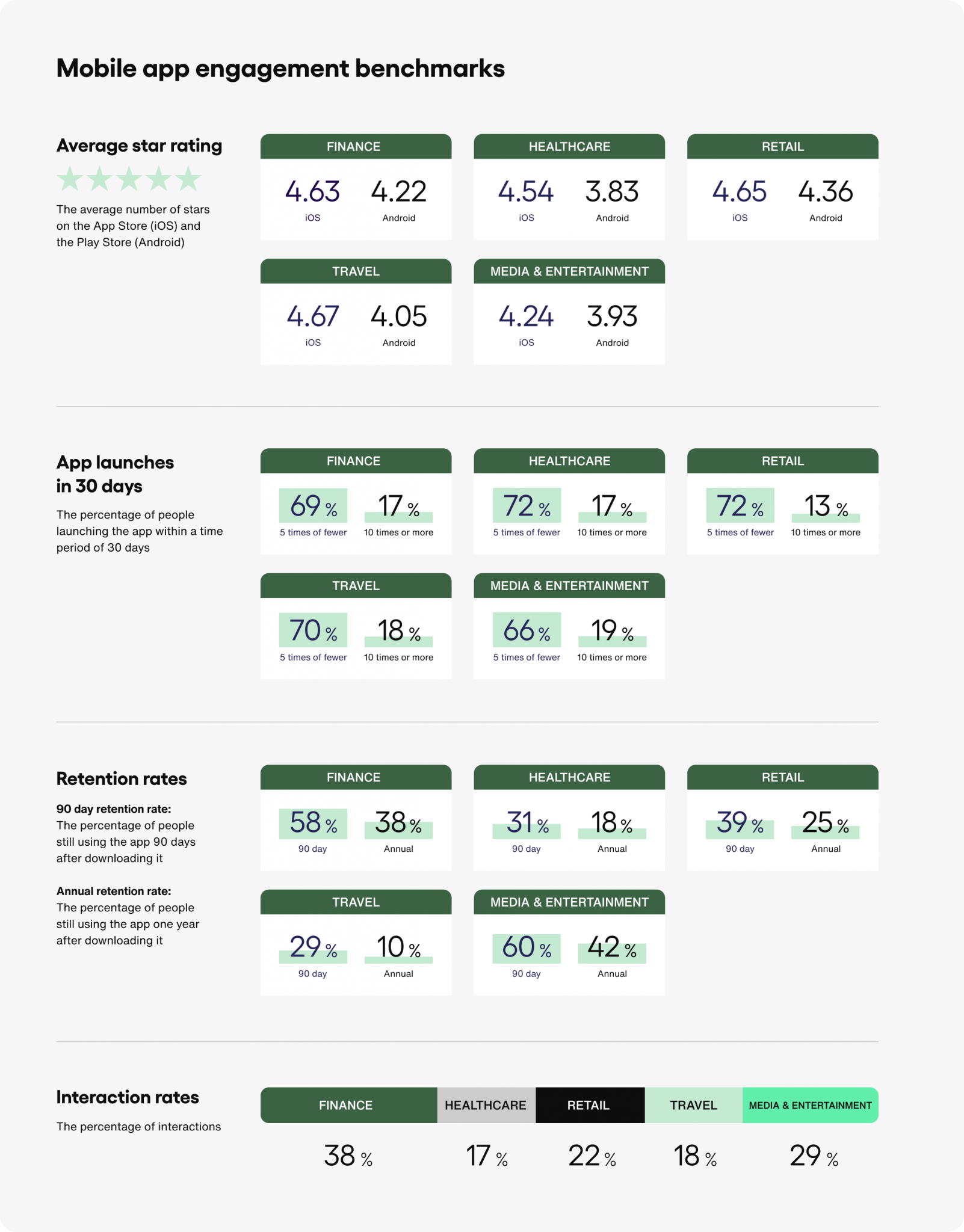Mobile app engagement benchmarks you need to know

So you’ve launched your mobile app and collected a slew of user engagement data. Congratulations!
While that’s a great start, have you thought about what all this data means? Is the app engagement level on par with other apps in your industry, or should you be worried that you might be lagging?
Should you expect users to launch your app once a week or once a month? What’s typical for your industry, and where should you focus your resources to make improvements?
To answer these questions, you don’t have to shoot in the dark – you can see how you measure up by comparing your data with mobile app engagement benchmarks. In this blog, we’ll show you the importance of mobile app engagement benchmarking, dig into some industry benchmarks for app engagement, and then show you actionable steps you can take right away to improve engagement rates. Let’s dive in!
What is mobile engagement benchmarking?
Mobile app benchmarking compares your app’s performance with that of similar apps in your industry. You can see how you stack up and what you can do to improve metrics such as downloads, Daily Active Users (DAU), Monthly Active Users (MAU), retention rates, revenue, user sentiment, and Customer Lifetime Value (LTV).
Benchmarking against your competitors helps you set realistic and meaningful performance standards. It can act as a reality check on the path to ensuring that your app achieves its objectives. If you find that your app isn’t up to the mark, you can pinpoint where to make improvements. If your app leads the pack, you can double down on successful tactics.
Typically, you should benchmark your app against those similar in scope and functionalities (i.e., your current competitors) to get an accurate view of the app’s performance. You may also look at your aspiration competitors to inform your growth strategy.
4 important benefits of mobile app engagement benchmarking
So why should you undertake a benchmarking initiative in the first place? What does it achieve? Here are 4 key benefits of getting your mobile app engagement benchmarks:
- Gain market visibility: Benchmarking gives you a realistic and accurate understanding of your app’s performance. For example, you might want to pop the champagne bottle when you see a 100% year-over-year (YoY) growth. But you shouldn’t be celebrating too soon if your competitors grew by 200%!
- Set meaningful goals: Benchmarking provides context and details about your performance and market positioning. This helps you set specific and relevant goals to improve your KPIs faster and more cost-efficiently.
- Inform product strategies: Insights from benchmarking can help you decide which features to add and how to craft your product strategy. For instance, after comparing with competitors’ successes, you may realize that you need to revisit your revenue model to boost income or increase your ad spend to drive app downloads.
- Save costs and increase ROI: Benchmarking shows you what works and what doesn’t so you can focus your time and resources to maximize results. The benchmarks will also serve as guardrails to help you keep your eyes on the prize and reach your goals faster.

[FREE TOOL] How does your app's engagement score compare to industry standards?
Mobile app engagement benchmarks by industry
Looking at overall benchmarks can give you insights into general consumer trends and what works for most businesses. But you may be comparing apples to oranges if your app serves highly specific audiences or purposes. For example, a fitness app may want users to engage with its content once a day, while a travel booking app may aim to have users log in twice a year.
We have broken down mobile app engagement benchmarks by industry and device to give you a more granular view of how your app measures up. Check out the below infographic for the highlights, or scroll down for a more detailed explanation.

Mobile app engagement benchmarks for the finance industry
Fintech, banking, and insurance apps receive an average 4.63-star rating from iOS users and an average 4.22-star rating from Android users. 69% of users launch an app five times or fewer in 30 days, while 17% launch an app ten times or more.
The average 90-day retention rate is 58%, and the average annual retention rate is 38% in this sector, with banking apps showing higher user retention than fintech and insurance ones. Meanwhile, the average interaction rate is 38%, and the average response rate to interactions is 94%.
Building trust is essential in driving the adoption and retention of finance apps. Getting user feedback and implementing their suggestions demonstrates that you value customers’ input, which can help boost your app store ratings and increase customer satisfaction.
Mobile app engagement benchmarks for the healthcare industry
Medical and fitness apps get an average 4.54-star rating on the App Store and an average 3.83-star on the Google Play store. 72% of users launch an app five times or fewer in 30 days, while 17% launch an app ten times or more.
The average 90-day retention rate is 31%, and the average annual retention rate is 18%. However, the 90-day retention rate jumps to 70% after app users were asked a simple yes/no question about whether they love the app. The average interaction rate is 17%, and the average response rate to interaction is 95% for this sector.
Digital health has taken a great leap during the pandemic, and more consumers are now used to accessing medical services and fitness content via mobile technologies. Engaging users and getting their input is key to providing the features they need to achieve results and stay with your brand.
Mobile app engagement benchmarks for the retail industry
E-commerce and retail apps get an average 4.65-star rating from iOS users and an average 4.36-star rating from Android shoppers. 72% of users launch an app five times or fewer in 30 days, while 13% do so ten times or more.
The average 90-day retention rate is 39%, and the average annual retention rate is 25%, with in-store retailers outperforming their e-commerce counterparts. The average interaction rate is 22%, and the average response rate to interaction is 91% for this sector.
COVID has accelerated the adoption of retail apps. Brands must evolve their business models and mobile experiences (e.g., virtual try-on and in-store pick-up for online order) to meet consumer expectations. Brick-and-mortar retailers can also use mobile apps to engage customers in-store to deliver an omnichannel shopping experience and drive sales.
Mobile app engagement benchmark for the travel industry
Data from this sector comes from transportation, hospitality/tourism, and auto subcategories. The apps get an average 4.67-star rating on the App Store and an average 4.05-star rating on the Google Play store. 70% of users launch an app five times or fewer in 30 days, while 18% launch an app ten times or more.
These apps have an average 90-day retention rate of 29% and an average annual retention rate of 10%, with the auto subcategory leading the pack. The sector has an average interaction rate of 18% and an average response rate to interactions of 85%.
Travel is another industry highly impacted by the pandemic. COVID prompted companies to innovate and rethink their strategies. Customer engagement has become more important than ever to help brands cultivate loyalty, improve retention, and shift market share during the recovery phase.
Mobile app engagement benchmark for the media and entertainment industry
Data from subcategories including news, telco, technology, games, sports, and music show that apps get an average 4.24-star rating from iOS users and an average 3.93-star rating from Android audiences. 66% of users launch the app five times or fewer in 30 days, while 19% do so ten times or more.
These app categories see an average 90-day retention rate of 60% and an average annual retention rate of 42%, with news apps showing the highest numbers (72%, 56%) and games lagging (12%, 6%.) The average interaction rate is 29%, and the average response rate to interaction is 92%.
Regardless of industry, mobile apps have become a critical channel for reaching audiences no matter where they are. Brands must leverage the latest technologies to connect experiences across multiple channels (e.g., website, social media) and initiate dialogue with the audiences to keep them engaged and coming back.
How to improve your mobile app engagement rates
Now that you know where you stand, here are some steps to help you improve your mobile app engagement strategy:
- Streamline new user onboarding to increase adoption and strategically use push notifications – you can build them for iOS, Android, React Native, and the web – to keep users engaged at the right moments.
- Launch features that meet users’ needs and deliver a consistent, intuitive customer experience to encourage users to explore all the functionalities of your app.
- Develop a seamless cross-channel user experience (e.g., use your app to enhance in-store shopping) to build customer relationships at all touchpoints.
- Focus on user retention instead of user acquisition by proactively engaging with customers via in-app messaging and live chat support. For example, you can build chat for iOS and Android, as well as for cross-platform applications with React Native, or Angular.
- Use your app as a listening channel to gather user feedback and apply the insights to inform your product roadmap.
- Deliver a relevant and personalized experience by allowing users to design their mobile experience based on individual preferences.
Benchmarks can help you understand your app’s performance relative to other apps. But ultimately, performance is dependent on your specific app and users. Whether it’s through a personalized sales concierge or proactively sending important news and updates, interacting with your audience to gain insights is an effective way to identify the best ways to engage with them.
In-app chat, video, and voice calls are ideal channels to help increase engagement across the board, regardless of where you stand on the industry benchmarks. You can interact with your audience in real-time and promptly respond to their questions and requests to keep them in your app.
You can also use these tools to gather user feedback or help customers make purchasing decisions at the right moment to increase engagement and conversion rates. These one-to-one interactions are critical for delivering a personalized experience that’ll reduce churn and keep your customers coming back.
But building a chat UI is a lot of work—how can you add the functionalities to your app without diverting resources from building the core features that meet your users’ needs?
The good news is that you don’t have to reinvent the wheel. With Sendbird’s ready-to-ship UIKit, you can add robust, scalable, and reliable interactive features to your app in no time. Sign up for Sendbird to see how easy it is to add chat to your app and boost engagement.









